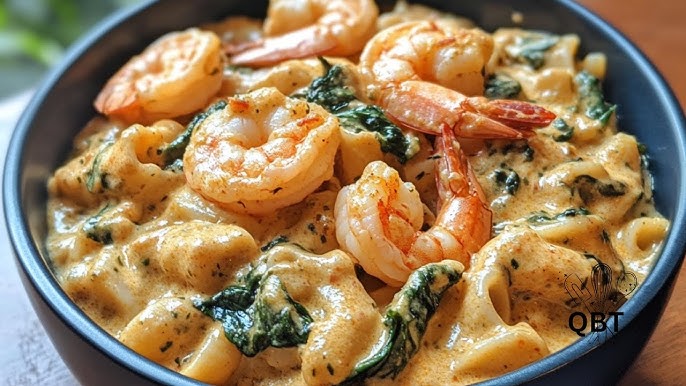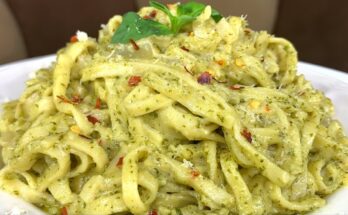Scampi Sauce Recipe: If you’ve ever dug into a plate of shrimp scampi and thought, “Wow, this sauce is incredible,” you’re not alone. Scampi sauce is one of those simple yet magical creations that transforms ordinary ingredients into a restaurant-quality dish. At its core, scampi sauce is a buttery, garlicky, lemon-infused delight, often enhanced with a splash of white wine. It clings to pasta, coats shrimp, and brings life to any meal it touches.
Scampi sauce isn’t just about flavor; it’s about experience. The rich aroma of garlic sizzling in butter, the zing from freshly squeezed lemon, and the subtle depth that white wine brings make this sauce unforgettable. Whether you’re looking to impress dinner guests or whip up a quick weeknight meal, scampi sauce is a go-to.
Its popularity stretches far beyond Italian-American cuisine, even though it has Italian roots. The term “scampi” refers to a type of small lobster found in Europe, but in the U.S., it’s mostly used to describe the style of preparation — usually with shrimp. And the sauce? It’s the star of the show.
Essential Ingredients for Scampi Sauce
Creating a perfect scampi sauce is all about the ingredients. Each component brings a unique note to the symphony of flavors. Here’s what you need:
Fresh Garlic and Butter
Garlic is the backbone of any scampi sauce. You want it fresh — none of that jarred stuff. Thinly sliced or finely minced, it should be sautéed just until it’s fragrant. Burnt garlic is bitter, so timing is everything.
Butter provides the rich, silky base that carries all the other flavors. Opt for unsalted butter so you can control the seasoning yourself. If you’re feeling fancy, a pat of high-quality European butter can elevate the sauce significantly.
White Wine and Lemon Juice
Dry white wine is key. It adds acidity and complexity without overpowering the other flavors. Sauvignon Blanc or Pinot Grigio are excellent choices. If you prefer not to cook with wine, a little chicken broth with extra lemon juice can be a good substitute.
Speaking of lemon — its juice brightens the sauce, cutting through the richness of the butter. Don’t skip the zest either; it adds a layer of freshness that’s hard to beat.
Herbs and Seasonings
Parsley is the classic herb used in scampi sauce, adding a pop of color and a mild peppery flavor. A pinch of red pepper flakes brings a subtle heat, while salt and black pepper round everything out. Some people like to throw in a touch of oregano or thyme for more depth — feel free to experiment.
These ingredients, while few, work in harmony to create a sauce that’s anything but basic. Keep them fresh and balanced, and your scampi sauce will never disappoint.
Choosing the Right Seafood for Scampi
While shrimp is the classic protein paired with scampi sauce, it’s not your only option. Here’s how to pick the right seafood for your version of scampi.
Shrimp: The Classic Choice
Shrimp and scampi sauce are a match made in culinary heaven. The sweet, briny flavor of shrimp complements the buttery, garlicky sauce perfectly. Go for large or jumbo shrimp — they hold up well to the sauce and offer a satisfying bite.
Fresh or frozen shrimp work fine, just make sure they’re peeled and deveined. Leaving the tails on adds a nice touch for presentation but isn’t mandatory.
Other Seafood Options That Work Well
Not a shrimp fan? No problem. Scampi sauce is versatile enough to work with other seafood too. Here are a few great alternatives:
- Scallops: Their mild, sweet flavor and firm texture make them an excellent substitute.
- Lobster or Langoustines: A more luxurious option, perfect for special occasions.
- White Fish: Cod or halibut can soak up the sauce beautifully, though they’re more delicate.
The key is to choose seafood that cooks quickly and won’t overpower the sauce. Let the scampi sauce be the star.
Step-by-Step Guide to Making Scampi Sauce
Alright, now for the main event — making scampi sauce from scratch. It’s quick, easy, and only takes about 10-15 minutes. Here’s how to do it:
Step 1: Preparing Your Ingredients
First, gather everything and do your prep. You’ll need:
- 4 tablespoons unsalted butter
- 4 cloves garlic, thinly sliced
- ½ cup dry white wine
- Juice and zest of 1 lemon
- Salt and pepper to taste
- ¼ teaspoon red pepper flakes (optional)
- 2 tablespoons chopped fresh parsley
If you’re using shrimp, have them peeled, deveined, and patted dry.
Step 2: Sautéing Garlic in Butter
Melt the butter in a large skillet over medium heat. Once it starts to bubble, add the garlic. Sauté for about 1-2 minutes — just until it’s golden and fragrant. Stir frequently and watch it closely to avoid burning.
Step 3: Deglazing with White Wine
Pour in the white wine to deglaze the pan. This means lifting all those tasty browned bits off the bottom. Let the wine simmer for 2-3 minutes until it reduces slightly and the alcohol cooks off.
Step 4: Adding Lemon Juice and Seasonings
Next, stir in the lemon juice, zest, salt, pepper, and red pepper flakes. Let the sauce simmer for another 1-2 minutes so the flavors meld together.
Step 5: Simmering to Perfection
If you’re adding shrimp or another protein, now’s the time. Add them to the sauce and cook until they’re just done — shrimp should be pink and opaque. Sprinkle the chopped parsley on top, give it a final stir, and you’re done.
This process creates a sauce that’s bold, bright, and buttery with just enough kick to keep things interesting.
Cooking Tips for the Best Flavor
Getting your scampi sauce just right doesn’t take a lot of effort, but a few pro tips can make a big difference.
- Use fresh ingredients. It really does matter. Fresh garlic, real lemon juice, and good-quality butter will elevate the dish.
- Don’t skimp on the butter. It’s the foundation of the sauce, so go big or go home.
- Keep the heat moderate. High heat can burn garlic fast, and overcooked shrimp is rubbery. Medium heat gives you control.
Want even more flavor? Let the shrimp marinate in lemon juice and garlic for 10 minutes before cooking. You’ll thank yourself later.
How to Serve Scampi Sauce
Scampi sauce is a superstar when it comes to versatility. It’s not just a one-dish wonder; it plays well with a variety of foods, transforming everyday meals into something extraordinary. Let’s talk about the best ways to serve this golden, garlicky masterpiece.
Over Pasta
This is probably the most iconic pairing — shrimp scampi over a bed of perfectly cooked pasta. Linguine and angel hair are top choices because their delicate strands absorb the sauce beautifully. You get a forkful of buttery, lemony goodness with every bite. Don’t forget to toss the pasta directly into the sauce pan so it can soak up every last drop. A sprinkle of Parmesan cheese on top? Perfection.
Want to level it up? Add some sautéed spinach or cherry tomatoes for color and nutrition. You could even mix in some freshly grated lemon zest for an extra zing.
With Crusty Bread
Sometimes, the sauce itself is the main event — and what better way to enjoy it than with a loaf of warm, crusty bread? Whether it’s a sourdough baguette or a thick slice of ciabatta, the bread acts like a sponge, soaking up every last bit of that delicious butter and garlic.
This option is great for casual dinners or appetizers. Place the sauce in a shallow bowl, surround it with sliced bread, and you’ve got an irresistible dip. You’ll be amazed how fast it disappears.
As a Topping for Grilled Proteins
Got leftover scampi sauce? Don’t waste it! Drizzle it over grilled chicken breasts or pan-seared fish fillets for an instant flavor boost. It’s also phenomenal over grilled tofu or vegetables like zucchini and asparagus.
This method turns a plain protein into a five-star dish with almost zero effort. Think of scampi sauce as your secret weapon in the kitchen — one spoonful can elevate the entire meal.
Storing and Reheating Scampi Sauce
Scampi sauce is best enjoyed fresh, but that doesn’t mean you can’t make it ahead of time or save leftovers. With the right storage and reheating methods, you can still enjoy that rich flavor the next day.
Best Practices for Refrigeration
First things first — let the sauce cool completely before storing. Once it’s at room temperature, pour it into an airtight container. It should keep well in the fridge for up to 3 days.
If your sauce includes seafood like shrimp or scallops, aim to consume it within 1-2 days for the best taste and safety. Seafood tends to lose its texture and flavor more quickly than other proteins.
Label your container with the date so you know exactly how long it’s been sitting there. Trust me, it’s a life-saver when your fridge starts to look like a mystery box.
Reheating Without Losing Flavor
When reheating scampi sauce, low and slow is the way to go. Toss it into a skillet over medium-low heat and stir frequently. If it seems too thick or begins to separate, add a splash of water, white wine, or lemon juice to bring it back to life.
Avoid using the microwave, especially if there’s seafood involved. The uneven heating can make shrimp rubbery or dry out the sauce. A stovetop reheating session takes just a few minutes and preserves the flavor beautifully.
If you’re reheating sauce only (without protein), consider freshening it up with a bit of garlic or lemon zest to revive the taste.
Common Variations of Scampi Sauce
One of the best things about scampi sauce is its adaptability. While the traditional version is always a hit, sometimes a little twist can take it to the next level. Here are a few popular variations that cater to different tastes and dietary needs.
Creamy Scampi Sauce
If you’re craving something richer, a creamy scampi sauce hits the spot. Just add a splash of heavy cream after the wine has reduced. This creates a luscious, velvety texture that clings beautifully to pasta or proteins.
You can also mix in grated Parmesan for an Alfredo-like finish. It’s indulgent, satisfying, and perfect for date nights or dinner parties when you want to impress.
Spicy Scampi Twist
Love a little heat? Amp things up with extra red pepper flakes or even a touch of cayenne. For serious spice lovers, a dash of hot sauce or a few slices of fresh chili peppers can bring some real fire.
This variation pairs particularly well with shrimp and noodles, giving you that spicy-sweet contrast that’s totally addictive.
Dairy-Free Alternatives
If you’re lactose intolerant or following a dairy-free diet, don’t worry — you can still enjoy scampi sauce. Swap out the butter for a plant-based version or use olive oil for a slightly different flavor profile. While you won’t get the same richness, the garlic and lemon still deliver plenty of punch.
Some people also like to add a spoonful of nutritional yeast for that umami kick, mimicking the depth that butter provides.
Experiment with these variations to find the one that fits your palate. Scampi sauce is more than a recipe — it’s a canvas.
FAQs about Scampi Sauce Recipe
There’s a lot to love about scampi sauce, and naturally, a few common questions pop up, especially if you’re making it for the first time or looking to tweak the recipe. Let’s tackle some of the most frequently asked questions to help you master this savory classic.
Can I Make It Without Wine?
Absolutely! If you prefer not to use wine — whether for dietary, religious, or taste reasons — you have solid alternatives. A good substitute is low-sodium chicken broth with a splash of lemon juice or white wine vinegar. This combo maintains the acidity that wine provides and helps deglaze the pan just as effectively.
You can also use vegetable broth for a vegetarian version. While the final flavor may be slightly different, it will still be delicious and close to the traditional scampi taste.
What’s the Best Substitute for Butter?
For a non-dairy or lighter version, olive oil works great as a substitute for butter. It brings its own unique depth, especially if you’re using a robust extra-virgin variety. Another option is ghee — which has a nutty, clarified taste and retains much of butter’s richness without the lactose.
If you’re going for a full vegan version, consider vegan butter or even a combo of olive oil and a touch of coconut cream to add some body to the sauce. Just make sure to taste as you go since every substitute brings its own flavor twist.
How Long Does It Last in the Fridge?
Plain scampi sauce (without any seafood) can be refrigerated in an airtight container for up to 3–4 days. If your sauce includes shrimp or another protein, try to eat it within 1–2 days to maintain optimal freshness and texture.
Always smell and taste-test the leftovers before reheating. Seafood can spoil faster than other ingredients, so when in doubt, throw it out.
Can I Freeze Scampi Sauce?
Yes, but with a caveat. While you can freeze scampi sauce, the texture may change a bit upon thawing — especially if it contains dairy or seafood. For best results, freeze the sauce without shrimp and add freshly cooked shrimp when reheating.
Store in a freezer-safe container, label it, and use it within 2 months for the best flavor.
What Type of Pasta Works Best?
Linguine, spaghetti, angel hair, or even fettuccine are all great choices. Thinner noodles tend to absorb the sauce better, but if you’re after a more filling dish, fettuccine offers a thicker bite. Gluten-free pastas and zucchini noodles are also excellent if you’re watching your carb intake.
Feel free to experiment — the beauty of scampi sauce is that it makes everything it touches taste amazing.
Conclusion
There’s a reason scampi sauce has stood the test of time — it’s a timeless blend of simplicity and flavor. With just a few pantry staples like garlic, butter, lemon, and white wine, you can create a dish that’s bold, comforting, and endlessly versatile. Whether you’re tossing it with shrimp and pasta for a classic dinner, spooning it over grilled chicken, or just sopping it up with warm bread, this sauce never fails to impress.
Cooking at home doesn’t have to be complicated. Scampi sauce proves that you don’t need a million ingredients or hours in the kitchen to create something extraordinary. It’s quick enough for weeknights and elegant enough for special occasions. Once you try it, you’ll find yourself coming back to it again and again.
So grab that skillet, fire up the stove, and get ready to make magic with this simple, satisfying, and absolutely delicious scampi sauce.



